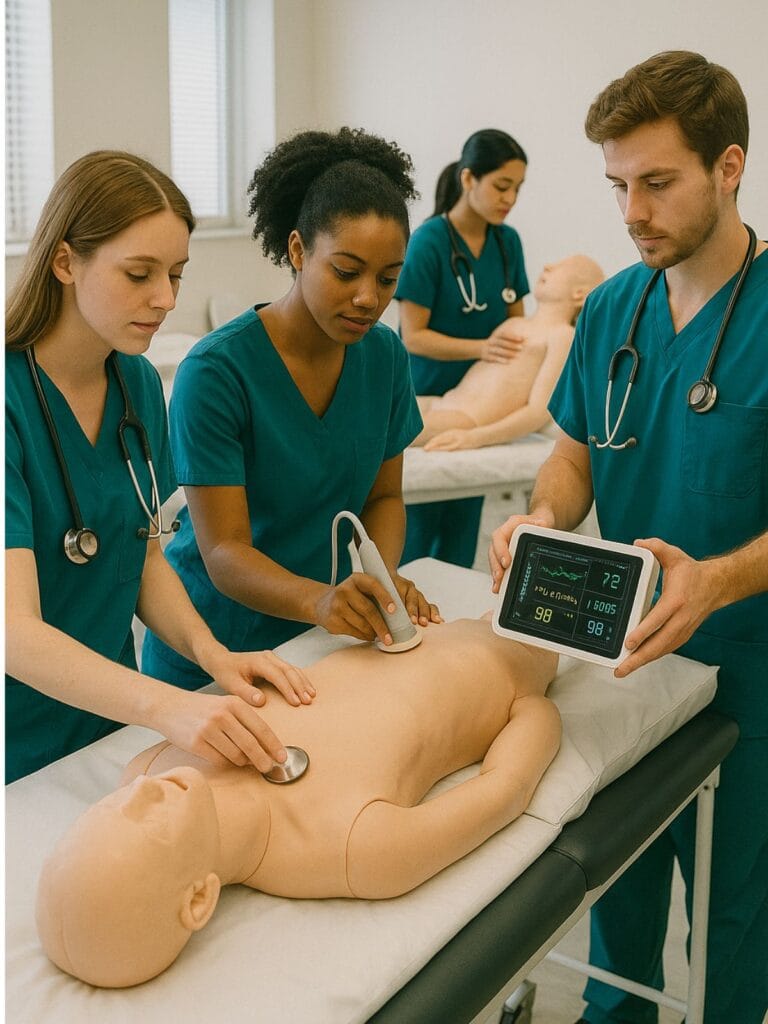Introduction
Powerful Career pathways such as the traditional four-year college degree are no longer the singular path to career success. In 2025 the job landscape is heavily changing, as are the educational pathways available to prepare individuals for that job landscape. Employers are starting to value practical skills, certifications, and usable skillsets more so than traditional theoretical education.
Career-oriented educational pathways provide an excellent option for learners who wish to enter specific industries, for example, technology, health care, or business, with less financial and time impact than a standard degree. Whether you are a high school graduate, an industry changer, a career changer, or a profession seeking to upskill advancement, career pathway options can serve as an expedited route into in-demand employment roles.
Let us take a look at the 7 most powerful career-oriented education pathways in 2025 that will lead to the best outcomes.
1. Technology Bootcamps (Coding, Cybersecurity & Data Science)
Why it Works
Technology bootcamps are focused, immersive, skill-based training, with an emphasis on getting you job-ready quickly. Most bootcamps are 3 to 12 months long and prepare students for employment in:
- Full-stack web development
- Cybersecurity analysis
- Data analytics or data science
- Cloud engineering
Bootcamps are appealing to anybody seeking to pivot their career quickly or upskill without going back to university. Bootcamp programs often provide career coaching, job search support, and real-world projects to help you get hired.
Top Programs
- General Assembly
- Springboard
- Flatiron School
- Google Career Certificates (Data Analytics, IT Support)
These programs frequently partner with top employers, and continuously adapt the curriculum based on current employer needs and demands. Courses can be taken online or in-person depending on your location and schedule.
Career Outcomes
Graduates find employment at companies like Amazon, Google, Meta, and tech start-ups. Entry-level positions often pay between $60,000 – $90,000 per year, and after a few years, graduates can earn over $120,000. Keywords in demand include Python, JavaScript, data visualization and others, reflecting today’s economic workforce demands and workforce context.

2. Healthcare Certifications and Associate Degrees
Why It Works
Healthcare is among the least vulnerable industries to recessions date. Career-focused paths will be certified medical assistant, dental hygienist or radiologic technologist. And those paths typically require 1-2 years of education.
Healthcare typically has some on-the-job training hours and clinical coursework. These requirements help the learner meet real-world scenarios. It should be noted that these professions all have some regulatory/certifying body that gives it credibility and reassurance that the knowledge is relevant in the job market.
Popular Options
- Nursing Assistant (CNA)
- Pharmacy Technician
- Diagnostic Medical Sonographer
- Licensed Practical Nurse (LPN)
- These occupations get paid respectable incomes, and allow great career progression from CNA to RN, or continuing into healthcare administration.
Salary and Job Demand
These healthcare careers have median salaries between $45,000 and $90,000 annually. The U.S. Bureau of Labor Statistics states careers in healthcare support are projected to grow as fast as or faster than average, making this a more reliable career path.

3. Skilled Trades and Technical Programs
Why it Works
Skilled trades are in high demand as aging workforce and lack of qualified workers create the need for skilled trades professionals. Generally, you do not have to have a degree, just vocational training or an apprenticeship.
These programs can be offered through community colleges, technical Institutes or through trade unions. Typically, they provide job placement assistance, hands-on experience, training, and industry recognized certifications.
Best Career-Focused Trades
- Electrician
- Plumber
- HVAC Technician
- Welding and Fabrication Trade
Typically, these types of jobs have job security, union protection and have opportunities to become entrepreneurial. By starting your own business or working freelance can lead to earning significantly higher income.
Where will you learn
- Local community college or trade school
- Union apprenticeship
- Online platforms such as Skillshare just to learn the foundational theory.
What can you Earn
Most trades professionals who work are generally in excess of $60,000 per year and usually have little to no debt. Most trade professionals like hvac techs or electricians earning well into 6 figures after time and licensing.

4. Business and Marketing Certifications
Why It Works
The number of digital marketing and project management jobs available on this planet are growing and still growing. You could learn SEO, social media marketing, or agile management in less than 6 months and start freelancing or working full-time.
These certification programs are recognized by employers, and many even include project-based assessments to highlight your abilities.
Top Certifications
- Google Digital Marketing
- HubSpot Inbound Marketing
- MP (Project Management Professional)
- Scrum Master Certification
You can even combine certifications to create an impactful and job-ready skill set. Many marketers create portfolios, case studies, or blogs about their experiences.
Career Opportunities
- Marketing Specialist
- Content Strategist
- Digital Analyst
- Freelance consultant
Salaries for these roles can range anywhere from $50,000 – $110,000 not including benefits, depending on the level of experience and the level of the position and location. Many of the biggest industries hiring digital marketing professionals are tech companies, retail companies, and the media.
Pro Tip: Combine certifications including a portfolio or blog to be more attractive to a potential employer.

5. AI, Machine Learning, and Automation Training
Why It Works
AI has disrupted every industry. There is a lot of opportunity in upskilling to get into AI/ML roles, and many of those jobs pay the highest salaries in tech.
AI training programs will have some combination of Python programming, deep learning, computer vision and natural language processing. Most will also have project-based learning that mimics real-world applications, such as: training a chatbot, building an AI-based recommendation system, etc.
Learning Paths
- Coursera: AI & ML Specializations, Stanford or DeepLearning.ai
- edX: MIT’s AI Courses
- Udacity: NanoDegrees in ML Engineering
Most of these types of courses are self-paced and include a certificate.
Roles and Salary
AI Engineer: $120,000+
Machine Learning Analyst: $100,000+
AI Product Manager: $90,000+
These programs are typically career-focused and maybe include a capstone project or mentorship to provide practical experience, so you are job-ready.

6. Creative and Digital Arts Programs
Why It Works
In the creator economy, design, animation, and content can be the leverage point to tap into a never-ending supply of jobs. Career programs in these areas include:
- Graphic Design
- UX/UI Design
- Motion Graphics and Video Editing
- 3D Animation and Game Design
Increasingly, companies value user experience and visual storytelling, so skilled creatives are in demand.
Top Schools & Platforms
- School of Motion
- LinkedIn Learning
- Domestika
- Adobe Creative Cloud Certification
In many cases, courses become mainly about your portfolio, and you access content about branding and storytelling. You will be trained in Adobe Photoshop, Adobe Illustrator, Adobe Premiere Pro, and Figma, but not necessarily taught how to use the software.
Job Options
- Freelance Designer
- UX Designer (applications/websites)
- YouTube Editor or Creator
- Game UI Artist
Each of these options is flexible in terms of making money, and allows you creative freedom. Entry-level roles would usually expect between $40,000 – $70,000 , while established or freelance professionals would make much more.
A degree is not necessary. You will need skills, a good portfolio and to keep going.

7. Remote Work & Freelancing Certification
Why It Works
Remote work has become mainstream, and platforms such as Fiverr, Upwork, and Toptal are access points to location-independent jobs and careers. Learning platforms have models for courses specific to freelancing.
This step will help you learn client communication, proposal writing, and pricing strategies; the three skills you need to be successful as a freelancer.
Skills in Demand
- Virtual Assistance
- Copywriting
- Email Marketing
- No-code Web Development (i.e., Webflow, Bubble)
All of these roles require you to have a laptop, an internet connection, and a skill. You can do your work from anywhere.
Where to Learn
- Skillshare
- Fiverr Learn
- Freelance University
- Coursera: Work Smarter with AI Tools
Career Benefits
The biggest advantage is that you are building your own income, you can work from anywhere, and you control your career growth over time. The income potential as a freelancer can be anywhere from $40,000 and $150,000 depending on the specialization, and the number of clients you can obtain successfully.

How to Choose a Career-Focused Learning Path
Here are five tips to make an informed decision:
✅ 1. Clearly Define Your Goal
Are you looking to get a job quickly, are you trying to change careers, or do you want to make more money? Your goal will guide your educational path.
✅ 2. Enrol in Courses or Certifications Offered by Reputable Institutions
Look for programs or certifications with accredited programs or have been sponsored by trusted institutions/companies like Google, IBM, AWS or top universities.
✅ 3. Consider Time vs Return
Some programs take on average 3 months to be completed, others take 2 years. Ask yourself: “What is my expected salary after completion?” This way, you can measure the ROI.
✅ 4. Assess Market Demand
Search Indeed, LinkedIn Jobs, or Glassdoor to see if there are postings for your target role in your area.
✅ 5. Action Based Learning
The best career-focused learning (education) will include the ability to apply that knowledge with real deliverables (projects). Build your portfolio (and resume) by interning or freelancing while you are learning.
Final Thoughts: The Future is for Those Who are Skilled
Career-focused education as an alternative to traditional, more expensive, and less flexible university options, has become the better choice for millions of learners around the world. The conversation has shifted away from “what you know” and shifted to what can you do with what you know.
These seven paths are purposeful, flexible, and results-oriented! You can either change careers or get started without having to spend years in school.
By following one of these 7 powerful paths, you can skip years of perceived courses and get into a well-paying, future-proof career today!



One Response